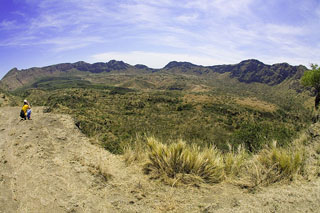Report on Fentale (Ethiopia) — 1 January-7 January 2025
Smithsonian Institution / US Geological Survey
Weekly Volcanic Activity Report, 1 January-7 January 2025
Managing Editor: Sally Sennert.
Please cite this report as:
Global Volcanism Program, 2025. Report on Fentale (Ethiopia) (Sennert, S, ed.). Weekly Volcanic Activity Report, 1 January-7 January 2025. Smithsonian Institution and US Geological Survey.
Fentale
Ethiopia
8.985°N, 39.906°E; summit elev. 2007 m
All times are local (unless otherwise noted)
Seismicity and deformation data acquired from satellite radar images indicated that a magmatic intrusion began in late September 2024 in the Afar Region between the Fentale caldera and Dofen volcano. Interferograms, which show upward and downward land movement using sequenced satellite radar data, indicated that a magmatic intrusion aligned along the central to northern part of an axis connecting these two locations began in late September 2024, according to the UK Centre for Observation and Modelling of Earthquakes, Volcanoes and Tectonics (COMET). Many felt earthquakes M 4 and above were associated with the intrusion. Data from 18 October indicated that the intrusion had slowed or paused. A second phase of the intrusion occurred during the end of 2024. An interferogram processed and interpreted by the Universitas Insan Pembangunan Indonesia (UNIPI) group in support of the Addis Abeba University showed very clear ground movement (over 40 cm of uplift) along almost the entire axis from Fentale to Dofen during 17-29 December.
Seismicity continued to be elevated in the region at least through 4 January and was likely associated with the intrusion according to the Ethiopian Geological Institute. A M 5 on 29 December located near Awash Fentale caused the collapse of more than 30 homes and cracks in roads and the ground in the Dulecha and Awash Fentale districts. On 3 January footage of increased activity at a geothermal area near Dofen was reported by news sources. The video showed water, sediment, and rocks being vigorously ejected above vents; the activity was non-volcanic in origin though it increased fears among residents that is was connected to the intrusion and potential volcanic activity. At least 10 earthquakes were recorded during 3-4 January with the largest, a M 5.8, occurring on 4 January. The Ethiopian Geological Institute reported that thousands of people had evacuated to other areas in the region.
Geological Summary. Fentale is a volcanic complex at the N end of the Main Ethiopian Rift that includes a main stratovolcano and caldera with various subsidiary features. Products are primarily rhyolitic obsidian lava flows with minor tuffs. Welded pantelleritic ash flows accompanied formation of a 2.5 x 4.5 km elliptical summit caldera, with steep-sided walls, that trends WNW-ESE, perpendicular to the rift. Post-caldera vents lie along the same orientation. Lava flows that appear to be more recent are present on the NE and SW flanks, and even darker trachytic and obsidian lava flows occur on the caldera floor. An eruption during the 13th century destroyed an Abyssinian town and church to the south. In 1820 CE basaltic lava flows effused from a 4-km-long fissure on the S flank; lava also flowed onto the caldera floor. During 2015 there was a seismic swarm and deformation NE of Fentale, caused by a dike intrusion that Temtime et al. (2020) determined was about 6 km long (striking N29°E) and 2 m wide, with a depth range of 5.4-8 km below the surface (volume change of about 33 x 106 m3).
Sources: Washington Post, The UK Centre for Observation and Modelling of Earthquakes, Volcanoes and Tectonics (COMET), Carolina Pagli, Università di Pisa, Crisis 24, Ethiopian Disaster Risk Management Commission (EDRMC), Ethiopian Geological Institute, VOA News

